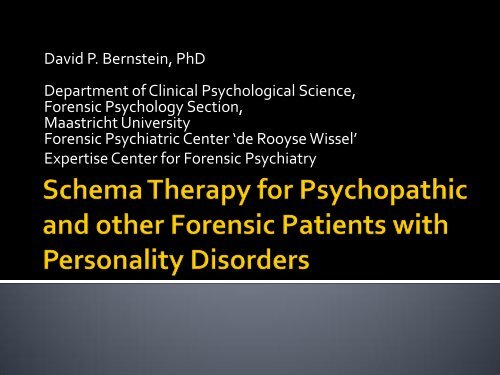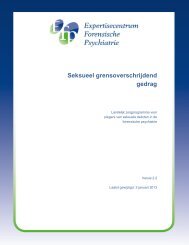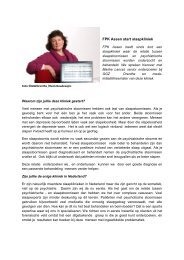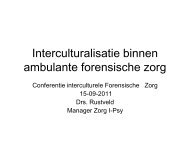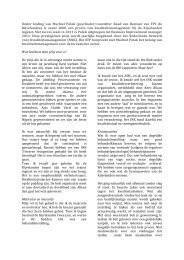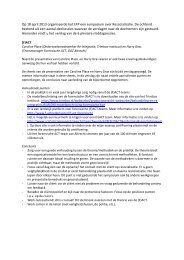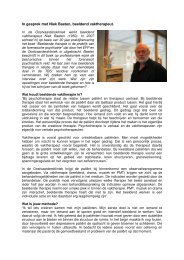Schema Therapy for Psychopathic and other Forensic Patients ... - EFP
Schema Therapy for Psychopathic and other Forensic Patients ... - EFP
Schema Therapy for Psychopathic and other Forensic Patients ... - EFP
You also want an ePaper? Increase the reach of your titles
YUMPU automatically turns print PDFs into web optimized ePapers that Google loves.
David P. Bernstein, PhD<br />
Department of Clinical Psychological Science,<br />
<strong>Forensic</strong> Psychology Section,<br />
Maastricht University<br />
<strong>Forensic</strong> Psychiatric Center ‘de Rooyse Wissel’<br />
Expertise Center <strong>for</strong> <strong>Forensic</strong> Psychiatry
A <strong>for</strong>mer en<strong>for</strong>cer in a criminal network contracted<br />
AIDS. When speaking of the people he’d hurt or<br />
killed, he suddenly broke into tears, <strong>and</strong> expressed<br />
remorse.<br />
A psychopathic patient told his therapist not to<br />
b<strong>other</strong> looking <strong>for</strong> emotions, because he was a<br />
psychopath. However, when he was suddenly<br />
hospitalized, <strong>and</strong> his girlfriend came to visit, he<br />
began to cry.<br />
A psychopathic patient hit a staff member <strong>and</strong> was<br />
placed in separation. When his therapist visited him<br />
<strong>and</strong> expressed sympathy, he cried.
Like <strong>other</strong> people, psychopaths aren’t the<br />
same way all of the time.<br />
They may be capable of vulnerable emotions<br />
under certain conditions.<br />
If we can break through to their vulnerable<br />
side, they may develop empathy <strong>and</strong> <strong>other</strong><br />
“moral emotions.”
An integrative therapy, combining cognitive,<br />
behavioral, object relations, <strong>and</strong> experiential<br />
approaches (Young et al., 2003).<br />
Treats personality disorder patients <strong>and</strong> <strong>other</strong><br />
longst<strong>and</strong>ing problems.<br />
Focuses on Early Maladaptive <strong>Schema</strong>s, coping<br />
responses, <strong>and</strong> <strong>Schema</strong> Modes.<br />
A moderate- to long-term therapy.<br />
Good evidence of effectiveness in outpatients<br />
with Borderline PD (Farrell et al., 2009; Giesen-<br />
Bloo et al., 2006; Nadort et al., 2009).
An emotional state or “part of the self” that<br />
temporarily dominates a person’s thoughts,<br />
feelings, <strong>and</strong> behavior<br />
<strong>Schema</strong>s = traits, modes = states<br />
Modes combine Early Maladaptive <strong>Schema</strong>s <strong>and</strong><br />
maladaptive coping responses<br />
In severe personality disorders, <strong>Schema</strong> Modes are<br />
largely dissociated from one an<strong>other</strong><br />
<strong>Schema</strong> Mode “flipping” or switching
Self-Aggr<strong>and</strong>izer<br />
Bully <strong>and</strong> Attack<br />
Paranoid -<br />
Overcontroller<br />
Conning -<br />
Manipulator<br />
Detached<br />
Protector<br />
Angry Protector<br />
Detached Self-<br />
So<strong>other</strong><br />
Predator Abused/Humiliated/<br />
Ab<strong>and</strong>oned Child<br />
Lonely Child<br />
Impulsive Child<br />
Angry Child<br />
Bernstein, Arntz, & de Vos, 2007
Funded by the Netherl<strong>and</strong>s Ministry of Justice, the Expertise<br />
Center <strong>for</strong> <strong>Forensic</strong> Psychiatry, Maastricht University’s Faculty<br />
of Psychology <strong>and</strong> Neuroscience, <strong>and</strong> the 7 participating TBS<br />
clinics
Test the effectiveness of ST versus TAU in<br />
male <strong>for</strong>ensic patients with Antisocial,<br />
Borderline, <strong>and</strong> Narcissistic with regard to:<br />
PD symptoms (SIDP-IV, SNAP)<br />
Institutional violence (incidents)<br />
Resocialization (authorized leave)<br />
Recidivism risk (HCR-20, SVR-20, START)<br />
Actual recidivism (arrests, convictions)
Note: N = 30; High PCL-R: >= 25, Low PCL-R: < 25<br />
Bernstein &<br />
Nijman, submitted
N = 30; Bernstein & Nijman, submitted<br />
N = 30
Therapists costs per patient over 3 years<br />
Training <strong>and</strong> supervision = €5.403<br />
Salary = €14.989<br />
Total costs = €20.392<br />
Annual cost of TBS stay per patient =<br />
€160.000<br />
Reduced length of stay to recoup full costs of<br />
the therapy = 2 months! Bernstein & Nijman,<br />
submitted
2,5<br />
2<br />
1,5<br />
1<br />
0,5<br />
0<br />
SFT TAU<br />
SFT > TAU, z = 1.71, p = .09; SFT, N = 6, TAU, N = 4.<br />
Psycho-<br />
<strong>Therapy</strong><br />
Arts<br />
<strong>Therapy</strong><br />
Van der Broek,<br />
Keulen-de Vos, &<br />
Bernstein, 2011
ST appears to be outper<strong>for</strong>ming TAU with respect to<br />
reducing risk, permission to receive leave, <strong>and</strong><br />
number of days to receive leave.<br />
ST appears to be especially effective at reducing risk<br />
more rapidly in psychopathic patients.<br />
<strong>Patients</strong> in ST show more vulnerable emotions,<br />
compared to TAU patients.<br />
ST can pay <strong>for</strong> itself by reducing length of stay.<br />
However, these findings are not yet statistically<br />
significant, <strong>and</strong> need to be confirmed in our larger<br />
sample <strong>and</strong> long-term follow-up.


